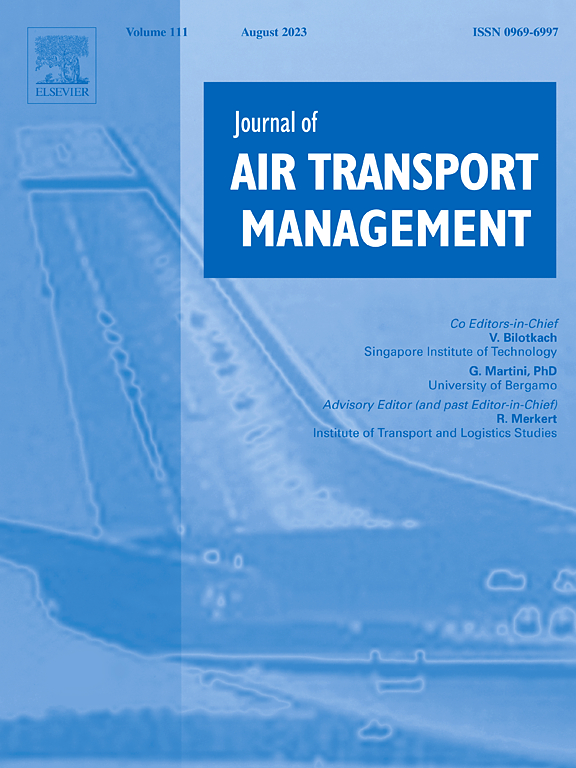Integrated hub airport location and fleets planning for airline-alliance-oriented freight transport system
IF 3.6
2区 工程技术
Q2 TRANSPORTATION
引用次数: 0
Abstract
The rapid growth of e-commerce has led to a surge in air cargo demand. Rather than operating independently, airlines are increasingly collaborating to capture a larger market share. This study investigates the integrated hub airport location and fleet planning problem under the context of airline alliances to enhance sustainable urban freight transportation. Three optimization models are proposed in different airline cooperation modes: i) model INDHL-INDFP, where airlines independently determine hub airport locations and fleet planning, ii) model INTHL-INDFP, where airlines collaboratively decide hub airport locations while planning fleets individually based on their cargo demand, and iii) model INTHLFP, where airlines make integrated decisions on both hub locations and fleet planning. These models are applied to networks of varying scales, and their performance is compared. Results indicate that integrated decision-making within airline alliances effectively reduces total system costs, with cost-saving benefits becoming more pronounced as network size increases. Additionally, this approach aligns freighter capacity with cargo demand, enhancing system resilience to demand fluctuations. Sensitivity analysis further reveals that the optimal number of hub airports depends on network scale and varies under different airline cooperation strategies. Moreover, network size significantly influences the determination of the maximum number of flights connected to other hubs for a hub. This study provides valuable insights into optimizing airline cooperation strategies to improve efficiency and sustainability in air cargo transportation.
以航空联盟为导向的货运系统的综合枢纽机场定位和机队规划
电子商务的快速发展导致航空货运需求激增。航空公司不再独立运营,而是越来越多地合作以获取更大的市场份额。本研究探讨航空联盟背景下的枢纽机场选址与机队规划问题,以提升城市货运的永续性。针对不同的航空公司合作模式,提出了三种优化模型:1)航空公司独立决定枢纽机场位置和机队规划的INDHL-INDFP模型;2)航空公司根据货运需求单独规划机队,协同决定枢纽机场位置的INTHL-INDFP模型;3)航空公司对枢纽机场位置和机队规划进行综合决策的INTHLFP模型。将这些模型应用于不同规模的网络,并比较了它们的性能。结果表明,航空公司联盟内部的综合决策有效地降低了系统总成本,随着网络规模的增加,成本节约的好处变得更加明显。此外,这种方法使货运能力与货物需求保持一致,增强了系统对需求波动的弹性。敏感度分析进一步表明,枢纽机场的最优数量取决于网络规模,在不同的航空公司合作策略下也有所不同。此外,网络规模显著影响一个枢纽连接到其他枢纽的最大航班数量的确定。本研究为优化航空公司合作策略以提高航空货运的效率和可持续性提供了有价值的见解。
本文章由计算机程序翻译,如有差异,请以英文原文为准。
求助全文
约1分钟内获得全文
求助全文
来源期刊

Journal of Air Transport Management
TRANSPORTATION-
CiteScore
12.40
自引率
11.70%
发文量
97
期刊介绍:
The Journal of Air Transport Management (JATM) sets out to address, through high quality research articles and authoritative commentary, the major economic, management and policy issues facing the air transport industry today. It offers practitioners and academics an international and dynamic forum for analysis and discussion of these issues, linking research and practice and stimulating interaction between the two. The refereed papers in the journal cover all the major sectors of the industry (airlines, airports, air traffic management) as well as related areas such as tourism management and logistics. Papers are blind reviewed, normally by two referees, chosen for their specialist knowledge. The journal provides independent, original and rigorous analysis in the areas of: • Policy, regulation and law • Strategy • Operations • Marketing • Economics and finance • Sustainability
 求助内容:
求助内容: 应助结果提醒方式:
应助结果提醒方式:


